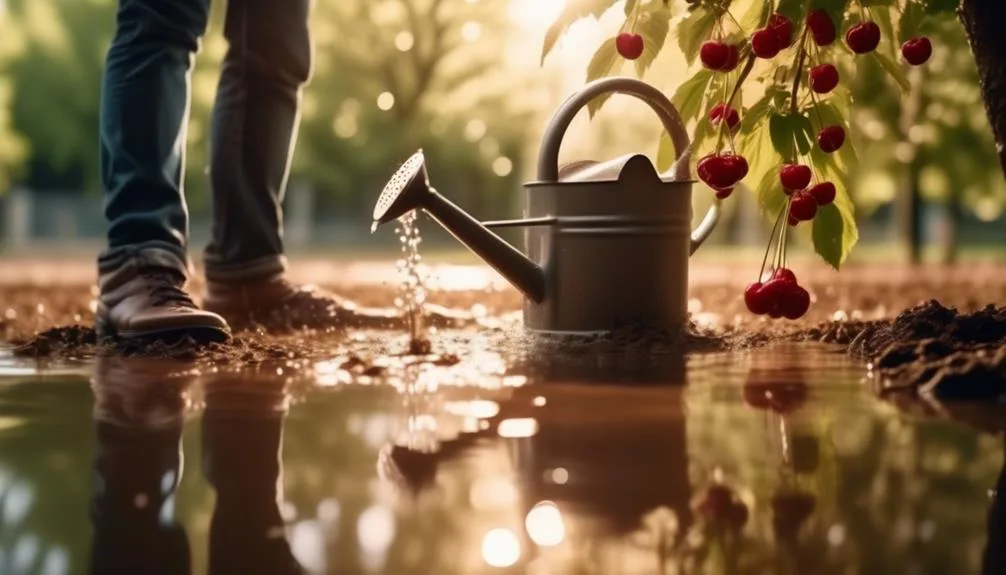Properly watering cherry trees is crucial for their health and fruit production. Finding the right balance is like a delicate dance – too much or too little water can harm the trees.
With the right knowledge, you can become an expert at keeping your cherry trees hydrated. Understanding their specific needs and how to water them correctly is essential for their well-being.
Let's explore the steps for watering cherry trees to help them thrive and produce abundant fruit.
Watering Frequency
You should water your cherry trees deeply and infrequently to encourage deep root growth and drought tolerance. Deep watering promotes root hydration and helps the roots grow deeper into the soil, making the trees more resilient to dry periods.
During the growing season, it's best to water deeply once a week, allowing the water to penetrate at least 12 inches into the soil. In hotter and drier conditions, increase the frequency to twice a week.
As the weather cools in the fall, gradually reduce the watering frequency to prepare the trees for winter dormancy. In winter, minimal to no watering is needed, as the trees are dormant.
Soil Moisture Levels
Maintaining optimal soil moisture levels is crucial for the health and growth of cherry trees throughout the year. To ensure your cherry trees thrive, follow these guidelines:
- Irrigation systems: Consider installing a drip irrigation system to deliver water directly to the root zone, minimizing water loss due to evaporation.
- Root hydration: Regularly check the soil moisture levels around the tree's root zone. The soil should be consistently moist but not waterlogged, as excessive water can lead to root rot.
- Mulching: Apply a layer of organic mulch around the base of the tree to help retain soil moisture and regulate soil temperature.
- Monitoring: Keep a close eye on weather conditions and adjust your watering schedule accordingly to maintain optimal soil moisture levels.
Proper Watering Techniques
To ensure optimal growth and health for your cherry trees, it's essential to employ proper watering techniques that promote efficient water absorption and minimize water loss. Deep watering is key to encouraging strong root development. Rather than frequent shallow watering, which can lead to surface roots, deep watering encourages roots to grow deeper into the soil, providing better stability and access to nutrients.
When watering, ensure that the water reaches at least 12 inches into the soil. Additionally, mulching around the base of the cherry trees offers numerous benefits. Mulch helps to retain soil moisture, reduces weed growth, and moderates soil temperature. It also prevents water evaporation, thus extending the time between watering.
These techniques will help your cherry trees thrive and produce an abundance of sweet, succulent fruit.
Watering Cherry Trees in Different Seasons
Watering cherry trees varies throughout the seasons, requiring adjustments to ensure proper hydration and growth. Here are essential tips for watering cherry trees in different seasons:
- Winter Watering: During winter, the ground may freeze, making it difficult for cherry tree roots to access water. Water the trees deeply before the ground freezes to provide adequate moisture during the dormant season.
- Spring Awakening: As the trees start budding, increase watering frequency to support new growth and blossoming.
- Summer Irrigation: In hot summer months, cherry trees need consistent watering to prevent stress and fruit loss. Deep, infrequent watering is ideal to encourage deep root growth and drought resistance.
- Fall Preparation: Decrease watering as the weather cools to help the trees prepare for dormancy.
Adapting your watering routine to each season will promote healthy cherry tree growth and abundant fruit production.
Signs of Overwatering and Underwatering
As your cherry trees' watering needs change throughout the seasons, it's essential to recognize the signs of overwatering and underwatering to ensure their optimal health and productivity.
Overwatering can lead to leaf discoloration, often appearing as yellowing or browning of the leaves, and wilting despite adequate moisture. Overwatering can also lead to root rot, which is characterized by a foul smell and dark, mushy roots.
On the other hand, underwatering may cause wilting, as well as stunted growth and dry, crispy leaves. Underwatering can also result in the roots becoming dry and brittle.
Monitoring your cherry trees for these signs will help you adjust your watering practices accordingly, promoting their overall well-being and fruitfulness.
Conclusion
Remember, by being mindful of soil moisture, adjusting watering frequency, and using proper techniques, you can nurture your cherry trees for thriving, fruitful seasons.
Finding the right balance is key to keeping your trees happy and hydrated.
Happy gardening!

My interest in trees started when I first saw the giant sequoias in Yosemite.
I was a teenager then, and I remember thinking, “I need to learn more about this.”
That moment stuck with me.
A few years later, I went on to study forestry at Michigan Tech.
Since graduating, I’ve worked in a mix of hands-on tree care and community education.
I’ve spent over ten years helping people understand how to plant, maintain, and protect the trees in their neighborhoods.
I don’t see trees as just part of the landscape.
They are living things that make a real difference in our daily lives.
